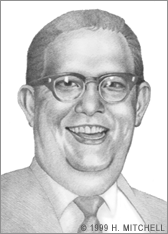James Fergason
James Fergason holds over 125 U.S. patents in liquid crystal technology, including the first practical use of liquid crystals. He is perhaps best known for his discovery of the twisted nematic field effect, which led to the creation of today’s liquid crystal displays (LCD).
Fergason was born in Wakenda, Missouri in 1934. He earned a BS in Physics at the University of Missouri in 1956 and took a research position at the Westinghouse Research Labs in Pennsylvania the following year. There, he organized the first American research team to study liquid crystals in 1957.
Many substances emit light when electrified, but liquid crystals are unique in that they reflect light when a current is passed through them. These crystals were first discovered in Germany in the 1880s, but it was not until the late 1950s that physicists began to consider applications for them. Fergason was at the head of the field. In the 1960s, as Associate Director of Kent State University’s Liquid Crystal Institute, Fergason was developing a liquid-crystal-based breast cancer screening apparatus when he made the discovery that became the basis of his greatest invention (1967).
The liquid crystal displays that were being developed in rival labs at the time applied voltage in “dynamic scattering mode,” which consumed too much power with poor results. Fergason used his discovery, the “twisted nematic field effect” of liquid crystals, to channel the current through the crystals efficiently, resulting in displays that provided good contrast and long life on minimal power (1969). In a typical display, the liquid crystal material is pressed between two thin layers of glass, which are embossed with an invisible electrode design of segmented bars that combine to make figures. When current is applied to the right electrodes, the crystal material reflects their ambient light, creating a readout by contrast with the unelectrified, and thus unreflecting, surrounding areas.
Fergason had earned his first patent (#3,114,836) in 1963, for his use of cholesteric liquid crystals in temperature-sensing applications —the first practical liquid crystal invention. This was followed by his first patent for a liquid crystal display (#3,410,999) in 1968 and for a “nematic liquid crystal twist cell display” (#3,627,408) in 1971. By then, he had already founded a company, ILIXCO, to manufacture the displays (1970). Fergason’s first major customer was Switzerland’s Gruen Watch Company. By 1977, most digital watches featured cool LCDs rather than glaring LEDs (light emitting diodes). Since then, LCDs have remade nearly every type of information display, including readouts on industrial, scientific, and medical apparatus, as well as calculators, computers, video games, and other consumer electronics.
All the while, Fergason remained at the head of his industry. He worked on miniature and passive displays, augmented reality, and safety devices during his last years. For example, as President of Optical Shields, Ltd., based in Silicon Valley, Fergason created and patented eyewear whose liquid crystal material becomes opaque instantly (in 1/20,000th of a second) when hit by any intense radiation, protecting the wearer’s eyes even from laser light. Optical Shields’ “Varilite Vision Panels” made the company a finalist in the 1992 Discover Awards. He was inducted into the National Inventors Hall of Fame in 1998 and won the Lemelson-MIT Prize for his achievements in 2006.
Fergason died on December 9, 2008, at the age of 74.


